Last year, I described how Seattle killed micro-housing through a series of legislative actions and administrative policy shifts that enacted a virtual ban on congregate micro-housing, pushed developers to build a larger and pricier form of micro-housing known as Small Efficiency Dwelling Units (SEDUs), inflated the size of SEDUs through new rules on minimum unit sizes, and denied SEDUs access to incentive programs that would make their rents more affordable.
Shortly after I published that article, I was pleased to get word that one of the various decision-making bodies that was the source of some of these reversals would reassess its particular role in this story. At the request of the mayor of Seattle, the Construction Code Advisory Board (CCAB), an obscure but powerful citizens’ panel that oversees interpretation and revision of Seattle’s building codes, agreed to take a second look at some of its recent interpretations, this time with Seattle’s affordability goals in mind.
The CCAB convened a special subcommittee to study how the building code regulates minimum unit size and how the Department of Construction and Inspection (SDCI) applies these rules to SEDUs. The building department has made it increasingly difficult to build SEDUs (which are theoretically legal down to 220 square feet) of a size anywhere close to the minimum. In many cases the new rules were producing SEDUs that were not meaningfully smaller than a conventional studio apartment (which started at 300 square feet before the new rules came into effect).
I was a voting member of this subcommittee and attended each of the meetings over several months. While the meetings were at times quite contentious, it appeared until the last that we might come together behind a helpful recommendation. In the end, this was not to be. The subcommittee voted five to three in favor of making some small improvements that will help with design flexibility but will do little to allow 220sf SEDUs as intended by the city council in its 2014 legislation.
When the subcommittee’s recommendation came back to the full CCAB, the board approved it, with one board member dissenting. When prodded by his colleagues for an explanation, he cited as one of his concerns that he did not accept the premise that the issues at hand had anything to do with affordability. Two other CCAB members concurred, stating that they “did not buy it.” Given this rejection of the underlying premise of the whole exercise, it is perhaps unsurprising that the CCAB was unconcerned by the prospect of failing to fix the problem.
During these meetings, I had a front row seat from which to listen to the concerns of CCAB members and participate in the discussion. Since CCAB is a technical review board, I had expected that its area of review might reasonably be confined to the purview of the building codes, namely issues of structural integrity, life safety, and health. The committee exhibited no such restraint. The meetings produced free-wheeling discussions touching on urban planning, politics, and morality that generated more heat than light. Along the way, some recurrent themes emerged that reflect deeply held beliefs on the part of the committee members. These beliefs are significant not only because they blocked progress to providing housing choices to thousands of mostly young, mostly moderate-income singles in Seattle, but because I suspect they are widely held among the general public. I recount them below, but first I set the scene.

What is the CCAB?
Seattle’s Construction Code Advisory Board (CCAB) comprises architects, engineers, and representatives of various construction trades. The mayor appoints members to three-year terms, and they advise the city on how to administer, adopt, and amend construction codes. They also weigh disputed code interpretations. For example, if a permit applicant disputes the building department’s interpretation of the code, the applicant can appeal to the CCAB for a hearing.
The problem
In 2014, Seattle amended its land use code, effectively banning congregate micro-housing (small private rooms with shared kitchens) while promoting small efficiency dwelling units (SEDUs), which are scaled-down studio apartments with complete kitchens and baths, and a minimum size of 220 square feet (sf). The building code has a parallel set of requirements, requiring a 220sf unit but also setting minimum dimensions for closet size, kitchen work area, and requiring a 150sf living room. As time went on, the building department (SDCI) began to tinker with the interpretation of these rules, excluding certain areas of the unit from counting toward its minimum size. The practical effect was that the 220sf minimum became almost impossible to achieve in real life; the smallest units expanded until they were at least 250sf and averaged around 280sf.
Chapter 1208 of the Seattle Building Code contains a requirement that a habitable room must measure 7 feet in any direction. The International Building Code Handbook explains that this clause means that any habitable room must contain a 7-foot diameter circle. If the circle fits cleanly inside the room, it meets the requirement. SDCI rejects the handbook’s interpretation, concluding that 1208.1 means the 7-foot minimum dimension must be met throughout each and every bit of the required room area.
 SDCI’s interpretation is not “wrong” per se. The handbook’s interpretation is not wrong either. The language of 1208.1 is ambiguous and requires the building department to decide what it means based on the practical effect.
SDCI’s interpretation is not “wrong” per se. The handbook’s interpretation is not wrong either. The language of 1208.1 is ambiguous and requires the building department to decide what it means based on the practical effect.
The practical effect: Less housing, more expensive
The current SDCI policy makes micro-housing less micro, inflating the size of the units, which does two things: the rent for each unit goes up, and fewer units fit in a building. Obviously, apartments of 280sf rent for more than apartments of 220sf. Less obviously, if the units are 20 percent larger, each construction project produces about 20 percent fewer units, exacerbating Seattle’s housing shortage and keeping much-needed affordable housing off of the market. In 2015, homebuilders permitted about 1,000 SEDUs in Seattle. Had this rule not been in effect, the number would have been higher, perhaps by as much as 200 units. Those missing units pushed an equal number of people back into the race for housing, competing harder for other available homes, bidding up rents, and pushing the losers of those bidding wars out of the city altogether.
Myth-busting
Pitted against the plain, empirical facts that smaller micro-housing is less expensive and more plentiful are a series of objections that were raised and addressed, only to resurface again at the next meeting. As these beliefs appear to be as tenacious as they are disprovable, a detailed review may be helpful. I counted five recurrent themes:
Myth #1: Human dignity
“A 220sf apartment is too small. Below a certain point, small housing is beneath human dignity. At a minimum, a person’s housing must accommodate conventional furnishings including a bed, table, and chairs.”
Sightline’s Alan Durning underlined the classism of this argument three years ago: housing expectations are socially defined and rise with affluence. To say that 220sf per person is beneath human dignity is to declare unfit for habitation the housing occupied by most people around the world today and by most people throughout history. Indeed, most people in most places throughout time have had available to them less than 200sf per person. Implicit in banning such housing choices as beneath human dignity is the implication that it’s better to live in a tent or under a bridge than to be “forced” to live in a home that is moderately cramped, at least by the standards of the middle-class professionals who sit on the CCAB. As Alan pointed out in this speech, “small is normal.”
But ignore all of that! We don’t even have to go there. I presented to CCAB a series of sample plans in various widths and depths to demonstrate that 220sf apartments with various floorplans (see below) can accommodate a suite of middle-class furnishings: a bed or sofa-bed, a table, and chairs.
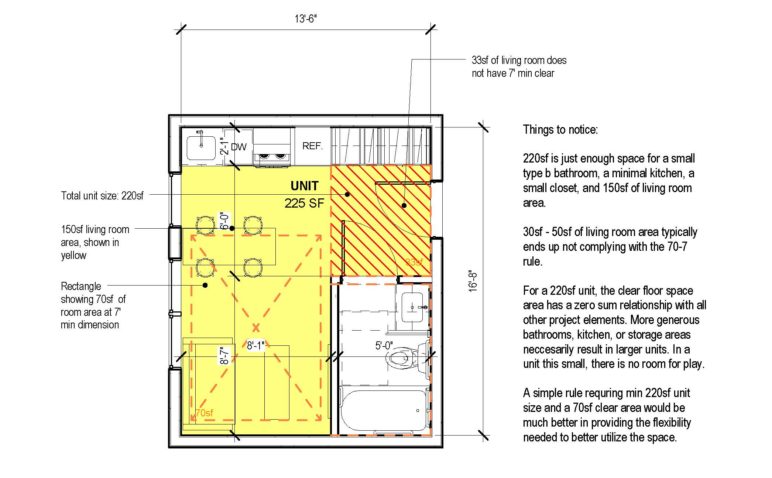
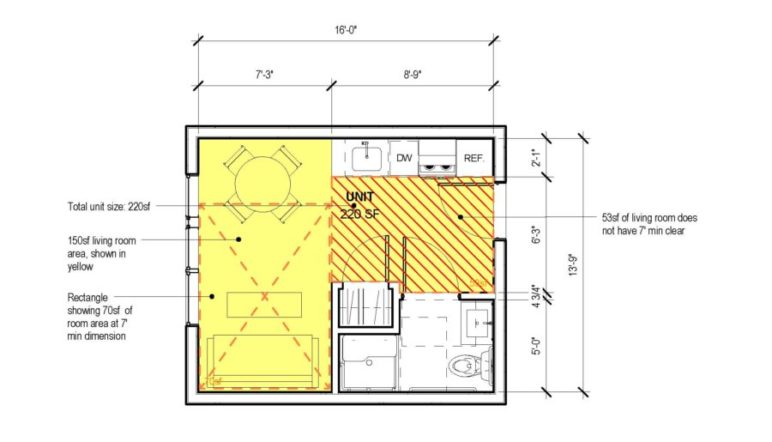
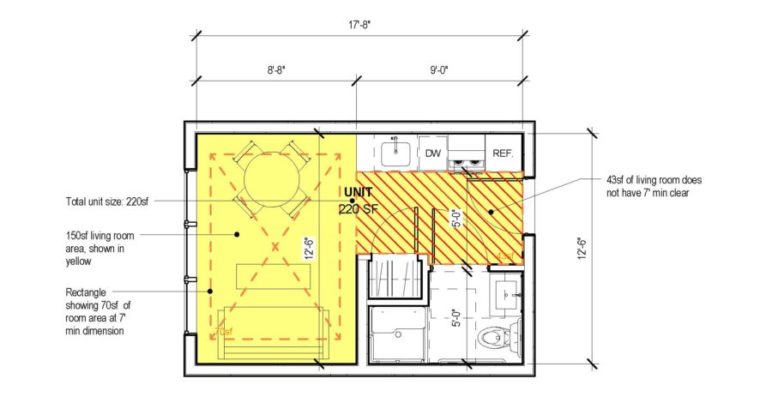
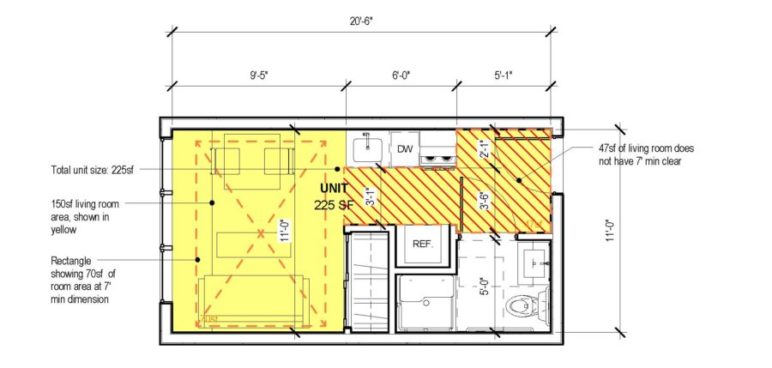
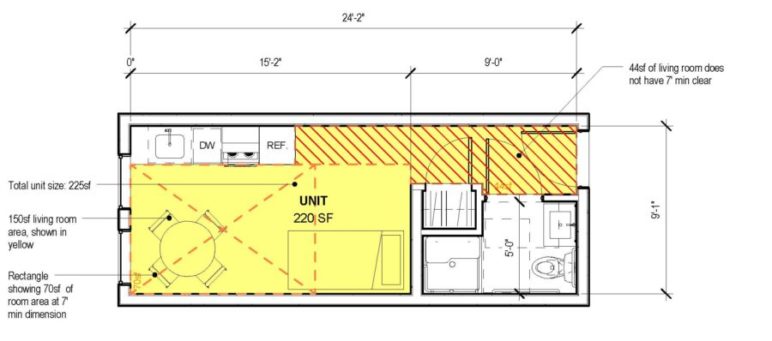

Myth #2: Fire safety
“Overly dense housing may be unsafe in a fire.”
Reflecting historical concerns about tenements as fire traps, CCAB asked the Seattle Fire Department (SFD) if it had any concerns about minimum unit size. The fire fighters shrugged. If the building is built to code, SFD has no concerns about life safety. All new apartments are equipped with fire-rated walls, floors, and ceilings; fire alarms; and numerous other active and passive safety features, including full building sprinkler systems. The simple fact is that people don’t die from fire in sprinklered buildings.
Myth #3: Public health
“Overly dense housing may be a health hazard, causing psychological stress, or the spread of disease.”
Committee members brought this up time and again. If you’re inclined towards this view, a Google search can easily provide you with opinion articles to confirm your bias. At CCAB’s invitation, experts from the University of Washington’s School of Public Health came to a meeting and gave an eyebrow-raising presentation. They had this to say about density:
- Density is good for people. Dense communities provide the population and tax base needed to support quality infrastructure, transportation, amenities, and services. Density helps create livable, walkable neighborhoods that promote healthy lifestyles, and it facilitates connections between neighbors that can improve people’s lives and well-being.
- Density is not a disease risk. Density and crowding were concerns a century ago before antibiotics and modern medicine. Today, they are not.
- Dense communities benefit from well-designed common areas that bring people together and help build social capital. Ironically, Seattle chose the opposite policy direction in 2014, killing congregate housing with common areas in favor of buildings full of self-contained SEDUs.
The health researchers also introduced to CCAB the National Healthy Housing Standard (NHHS), the public health field’s minimum performance standards for a safe and healthy home. It is written to help property owners and government agencies, using language that puts modern public health information into housing code parlance.
The NHHS minimum standard for a habitable room is 70sf, less than half of the 150sf living room size required for SEDUs. The NHHS is evidence-based, and the public health literature provides nothing that forms a rational basis for concern about unit size. The alternative to minimal housing is often no housing at all, NHHS notes, so maintaining a standard that is arbitrarily high can have real and terrible social costs. (Learn more here.)
Myth #4: Responsible stewardship
“Seattle’s construction boom is producing mostly small studios for single people. We need housing for families, not more micro-housing. Where does this stop?”
This was a widely cited concern, reflecting a belief that micro-housing makes up the lion’s share of housing production in Seattle—a belief has no basis in fact. According to researchers Dupre + Scott, the most reliable source of apartment data in greater Seattle, the homebuilding industry is producing 56 percent one-bedroom apartments in Seattle, 24 percent two-bedroom apartments, and 15 percent studio apartments. Even those studios are fairly large, at 465sf on average. Micro-housing is a niche market—an important niche in terms of providing market-rate affordable housing but decidedly not a substantial portion of overall housing production.
Increasing production of three-plus bedroom units for larger families is a legitimate concern, but suppressing micro-housing does not increase family housing. To the contrary, micro-housing helps keep houses available for families. The primary constraint on the production of family-sized housing is the general lockdown on land that is appropriate for “missing middle” development—rowhouses, townhouses, duplexes, stacked flats, and the like that are illegal in single-family zones, constrained to small areas of the city, and hampered by process bottlenecks that limit production. To the extent that micro-housing and family-sized housing are linked, they are complements: micro-housing allows singles to rent places of their own, rather than combining income with friends and roommates to bid up the rents of single-family houses.
Myth #5: Flim flammery
“This isn’t about affordability at all. This is about micro-housing developers trying to pad their profit margins.”
When push came to shove, most of the CCAB rejected the very notion that accommodating small studios in urban neighborhoods is an affordability priority. They “didn’t buy it.” It’s a jarring perspective that runs contrary to everything I’ve learned in architecture and development. I had to listen long and hard to understand what they meant.
Sightline focus groups of other Seattle residents find this perspective is surprisingly widespread: the idea that homebuilders are “just being greedy” and could “still make money if they charged reasonable rent.” The belief seems to be that, because housing used to cost less, it would still cost less were developers not seeking immoral rates of profit. The implication seems to be that allowing developers to rent apartments smaller than middle-class people would choose to live in is to “let them off the hook.” Rather than seeing the economic problem of a housing shortage—spiraling land prices, rising construction costs, sclerotic permit processes, bidding wars among homebuyers, rock-bottom vacancy rates in apartment buildings, surging local population and incomes—they tend to see a morality play. Developers have gotten greedy. They should knock it off and “do the right thing,” which apparently means building conventionally sized apartments and leasing them for the prices of yesteryear. It’s an appealing argument, but it’s little more than wishful thinking—the tempting notion that you can blame housing affordability problems on a small group of black-hatted villains.
The reality is more complicated. Virtually all of our housing stock is, and always has been, built by for-profit developers. Like all businesses, developers require profit in order to operate, and they seek to maximize profit where they can. But they also have to compete with each other for land, construction labor, and renters, which inherently limits their profitability. In a constrained housing market, the true beneficiaries reaping windfall profits are the owners of residential land. In Seattle, most of the residential land is the property of individual single-family homeowners. As the saying goes, “we have met the enemy, and he is us.”
The empirical case for the relationship between apartment size and rent is unimpeachable. It’s not even controversial. The figure below shows rents and sizes of all apartments in the greater Seattle area, according to Dupre + Scott. (It’s from the firm’s fall 2016 survey of all rental properties of 20 or more units, and it shows rents in 50sf ranges. You read the bottom axis as “up to 200sf, from 200sf to 250sf, from 250 to 300sf,” and so on. The values marked on the axis are the top values of each range.)

The figure shows that average apartments of fewer than 200sf (congregate dwelling units) rent for $868 a month, on average. At 350-400 square feet, average rents are already more than $1,000 a month. They rise to almost $2,200 a month for a large apartment of 1,450 to 1,500sf. Because these figures span parts of three counties and mix new and old apartments, they understate the price escalation by size in urban markets, where units are smaller and space costs more. Still, it makes clear the general relationship. Anyone in the housing business will agree that rents and sizes rise in lockstep, all else being equal. The real estate industry measures and discusses rents by the square foot, just as the rag trade measures fabric by the yard and grocers think in dollars per pound.
On micro-housing, it appears that the issue is settled: SEDUs will remain super-sized until further notice.
Perhaps CCAB members understand that rent and size correlate to one another but mean something different by affordability? In terms of housing policy, affordability has a conventional definition. If you are paying less than 30 percent of your income for your housing, your rent is considered affordable. At the lower end of the spectrum, you would expect a small (220sf) SEDU in a central location to rent for around $1,100 per month. (That’s more than in Dupre + Scott’s figure, because I’m talking about a brand new, in-city apartment.) A larger SEDU (280sf) might rent for around $1,300 per month. According to the Seattle Office of Housing’s rent tables, the small SEDU is considered affordable for someone making $44,000 a year, whereas the larger SEDU is affordable to someone making $52,000 a year. That’s a big difference, but when the CCAB members declared that they “didn’t buy it,” I don’t think they were necessarily denying that the smaller unit rents for less or rejecting a relationship between unit size, rent, and affordability.
Instead, I think CCAB’s rejection of the affordability nexus is rooted in a values system that says if you want to call your project affordable housing, it needs to be comparable in size and features to regular housing, but it simply needs to rent for less. From this point of view, affordable housing is what non-profits build—conventional middle-class housing with generous amenities and subsidized rents. If you hold to this ideal, when for-profit developers use affordability as a rationale for loosening restrictions or building smaller, the argument rings hollow as some kind of a con job, reframing pursuit of profit as a virtue.
There is not much one can say to combat this way of thinking. It is part of a widely held worldview, where policies founded on a mix of altruism, idealism, paternalism, and anti-capitalism generate housing scarcity, soaring rents, and displacement of poor people, all in the name of standing up for their rights and dignity. This is the template for how many prosperous cities with progressive electorates do housing policy. San Francisco has demonstrated exactly where it leads. Unless Seattle consciously charts a different course, it is doomed to follow the same path.
The Housing Affordability and Livability Agenda (HALA), on which I was honored to serve, was intended to achieve a more rational and effective housing policy. It produced a great blueprint, but it doesn’t mean much if the city doesn’t follow it. On micro-housing, it appears that the issue is settled: SEDUs will remain super-sized until further notice. CCAB had a chance to give a partial reprieve. It declined.
Seattle micro-housing is still dead.
[list_signup_button button_text=”Like what you|apos;re reading? Get our latest housing research right to your inbox.” form_title=”Housing Shortage Solutions” selected_lists='{“Housing Shortage Solutions”:”Housing Shortage Solutions”}’ align=”center”]
Thanks to Dupre + Scott for use of its data and permission to publish it. Alan Durning edited and contributed to this article.


Comments are closed.